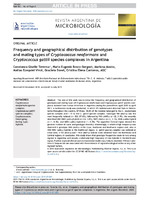Please use this identifier to cite or link to this item:
http://sgc.anlis.gob.ar/handle/123456789/1515| Title: | Frequency and geographical distribution of genotypes and mating types of Cryptococcus neoformans and Cryptococcus gattii species complexes in Argentina | Authors: | Taverna, Constanza Giselle Bosco-Borgeat, María Eugenia Mazza, Mariana Vivot, Matias Ezequiel Davel, Graciela Odelsia Canteros, Cristina |
Keywords: | Criptococosis;Cryptococcus;Cryptococcus neoformans;Cryptococcus gattii;Perfil Genético;Genotipo;Argentina | Issue Date: | 13-Jan-2020 | Journal: | Revista Argentina de microbiologia | Abstract: | The aim of this work was to know the frequency and geographical distribution of genotypes and mating types of Cryptococcus neoformans and Cryptococcus gattii species complexes isolated from human infections in Argentina during the period from April 2009 to April 2011. A multicenter study was conducted, in which 372 isolates were obtained from 61 laboratories throughout the country. Of those, 98.8% of the isolates belonged to the C. neoformans species complex and 1.1% to the C. gattii species complex. Genotype VNI (MATα) was the most frequently isolated (n=326, 87.6%), followed by VNII (MATα) (n=22, 5.9%), the recently described VNII-VNIV (aADα) hybrid (n=14, 3.8%), VNIV (MATα) (n=4, 1.1%), VNIII (αADa) hybrid (n=1, 0.3%), and VNIII (αADα) hybrid (n=1, 0.3%). The Argentine Central region showed the greatest number of cases and genotype diversity. Interestingly, a relative high frequency was observed in genotype VNII (MATα) in the Cuyo, Northeast and Northwest regions and, also in VNII-VNIV (aADα) hybrids in the Northwest region. C. gattii species complex was isolated at a low rate; 3 VGI (MATα) and 1 VGII (MATα) isolates were obtained from the Northwest and Central regions. In conclusion, this study shows that genotype frequencies seem to vary among regions in Argentina and reveals a relatively high frequency of rare hybrids in the Northwest region. Further regional clinical and environmental studies may help to elucidate if those variations in frequencies are associated with the existence of regional ecological niches or any other regional factors. |
Description: | Fil: Taverna, CG. ANLIS Dr.C.G.Malbrán. Instituto Nacional de Enfermedades Infecciosas; Argentina. Fil: Bosco-Borgeat, ME. ANLIS Dr.C.G.Malbrán. Instituto Nacional de Enfermedades Infecciosas; Argentina. Fil: Mazza, M. ANLIS Dr.C.G.Malbrán. Instituto Nacional de Enfermedades Infecciosas; Argentina. Fil: Vivot, ME. ANLIS Dr.C.G.Malbrán. Instituto Nacional de Enfermedades Infecciosas; Argentina. Fil: Davel, Graciela Odelsia. ANLIS Dr.C.G.Malbrán. Instituto Nacional de Enfermedades Infecciosas. Departamento de Micología; Argentina. Fil: Canteros, Cristina Elena. ANLIS Dr.C.G.Malbrán. Instituto Nacional de Enfermedades Infecciosas; Argentina. |
URI: | http://sgc.anlis.gob.ar/handle/123456789/1515 https://www.sciencedirect.com/science/article/pii/S0325754119300884 |
ISSN: | 0325-7541 | DOI: | 10.1016/j.ram.2019.07.005 | Rights: | Open Access |
| Appears in Collections: | Publicaciones INEI |
Files in This Item:
| File | Description | Size | Format | |
|---|---|---|---|---|
| 1-s2.0-S0325754119300884.pdf | Artículo en inglés | 1.4 MB | Adobe PDF |  View/Open |
Page view(s)
715
checked on Jan 8, 2026
Download(s)
119
checked on Jan 8, 2026
Google ScholarTM
Check
Altmetric
Altmetric
Items in DSpace are protected by copyright, with all rights reserved, unless otherwise indicated.

